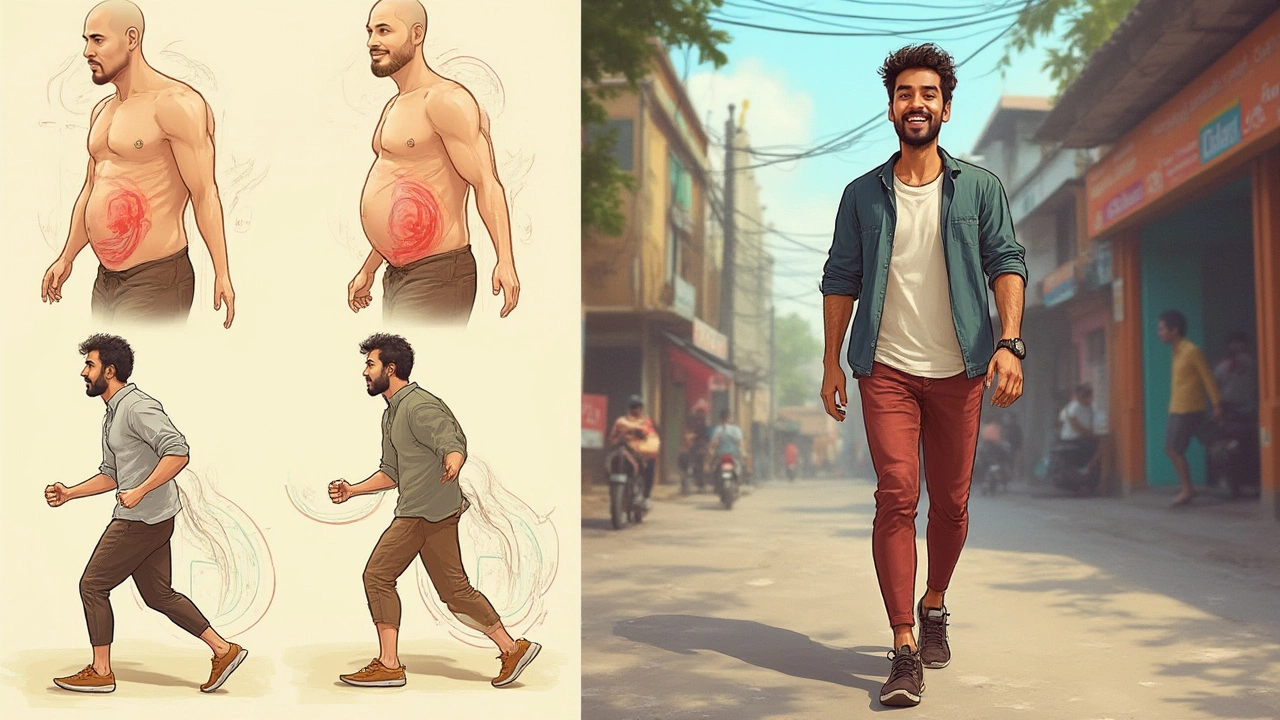Belly fat isn’t just about looks—it’s an annoying, stubborn guest most people want to evict. Every magazine claims the “magic move” for a flat stomach. But what if the answer is as simple as putting one foot in front of the other? That’s right: walking. Loads of folks swear by it. But does walking really burn belly fat, or are people just getting fooled by fitness fads? Let’s peel back the myths, check out real science, and dig into practical tips on burning belly fat with something as normal and easy as a walk.
What Happens in Your Body When You Walk?
Walking might seem basic, but your body kicks off a complex process every time you step out. When you walk, your muscles demand more oxygen, making your heart pump faster and your lungs work harder. This uptick in activity fuels your body to burn calories—and not just during the stroll, but for a while after, too. Walking also taps into your fat stores for energy after using up what’s floating around as sugar in your blood. This is where things get interesting in the fight against belly fat.
Belly fat, or visceral fat, hugs your organs and messes with hormones and inflammation. It’s sneakier and more damaging than the soft fat under your skin. The good news? Research from the American Journal of Physiology reported that people who added brisk daily walking to their routine lowered both subcutaneous and visceral belly fat, as measured by MRI, in just four weeks. The sweet spot was about 30-60 minutes most days. The muscle contractions from steady walking, especially at a quick pace, actually break down more fat for energy over time. It sounds simple, but that’s how the body works—steady, regular movement beats marathon heroics.
But walking isn’t just about burning calories on the spot. It tweaks your metabolism. Regular walks encourage your body to become better at burning fat even at rest, which scientists call increased "fat oxidation." This is especially true for people who stay consistent for weeks at a time. When you walk with intention—think a pace where you can talk but are breathing heavier—you’re nudging your body to use more stored fat for fuel, including that stubborn belly zone.
Here's a fun fact: You won’t just torch fat during the walk. There’s also something called "afterburn"—the calories you keep burning as your body recovers. While it doesn’t turn you into a calorie-burning machine, every bit adds up, especially when combined with other healthy habits. Pair walking with better sleep and smarter eating, and your fat-burning engine hums even louder.
How Much Walking Does It Take to See Results?
The idea of “spot reduction”—burning fat from a single spot like the belly—is mostly myth. But, that doesn’t mean your love handles are immune to your walking efforts. What actually happens is, when you consistently burn more calories than you take in, your body dips into stored fat. Guess where it loves to pull from? The gut.
In a telling 2022 study, participants who walked briskly for 30-45 minutes, five days a week, trimmed more belly fat and waist size than those who just dieted or were sporadic with their workouts. Some folks clocked their steps instead—around 8,000 to 10,000 daily was the “magic” number for steady fat loss. Want real numbers? Walking at a brisk pace (around 4 miles per hour) for 45 minutes can burn 200-300 calories, depending on your size. Over a week, this adds up fast—1,400 to over 2,000 calories, which makes a real dent in weight and fat stores if you’re not overeating.
Some people ask: Do I have to walk all at once? Not at all. Researchers found splitting walks—15 minutes after every meal, for example—not only ramps up fat burn, but keeps your blood sugar steady too. Another smart tweak is adding light inclines, like hills or stairs, which cranks up calorie use and really gets your core stabilizer muscles in on the action.
But here's where the rubber meets the road: consistency. One epic Sunday stroll can’t cancel out a week on the couch. Set a goal—daily, every other day, just make it regular.

Real-Life Strategies to Maximize Fat Burn While Walking
Bored with the same loop around your neighborhood? You don’t have to be. Take your walking game up a notch with a few tweaks. Start by making your pace your best friend. "Brisk" isn’t a fancy word—it just means fast enough that you can talk, but singing would leave you gasping. People aiming for belly fat loss should shoot for 60 to 75% of their max heart rate (if you want numbers, that’s about 130 beats per minute for most people in their 30s or 40s).
Mix up your walking routes to add some hills, patches of sand, or even a few flights of stairs. Why? These changes force your core and leg muscles to work harder, which means more calories torched. If you walk with your arms swinging vigorously (don’t be shy—you’re not alone), you’ll recruit your upper body and torch even more energy.
Try intervals: Walk briskly for 2 minutes, then pick up the pace for 1 minute. Repeat this cycle for 20-30 minutes. Intervals torch calories fast and have been shown to target belly fat more than strolls at a single slow speed. Want to keep it fun? Plug into an upbeat playlist or a motivational podcast—researchers at the University of Victoria found that people stick with walking longer and push harder when they’re entertained.
Small daily habits go a long way. Simple moves like walking to get groceries, taking phone calls on the move, or “walking meetings” at work add up. Add ankle or wrist weights for some extra calorie burn (just a little, you’re not training for strongman), but don’t compromise your natural walking form or risk injury by going too heavy.
- Wear comfortable, supportive shoes—your feet are carrying your fat-burning hopes.
- Drink water before and after to stay hydrated—dehydration can slow metabolism.
- Add some light stretches before you go and after you finish, especially for your hips and lower back.
- Walk with a friend or join a walking group for built-in encouragement.
Common Myths About Walking and Belly Fat
Maybe you’ve heard people say walking is “too easy” to burn real fat. That’s nonsense. Brisk walking burns nearly as many calories per hour as slow jogging—without hammering your joints. In fact, walking is safer for folks carrying extra weight or those with wonky knees. It’s gentle, yet gets the fat-melting job done if you keep at it.
Some think only hardcore workouts or gym machines can blast away belly fat. Here’s a reality check—researchers at Harvard tracked over 12,000 adults for 14 years and found the simple habit of walking briskly 30-45 minutes most days was just as effective for trimming waistlines as regular high-intensity training. Walking’s secret weapon? It also keeps your stress hormones lower, which is a big deal since high cortisol has been linked to belly fat. In other words, walking every day can stop your body from stashing extra fluff around your middle just because you’re stressed out.
Another myth: Walking on an empty stomach “burns more fat.” Science is mixed. While your body may use up more of its stored fat when fasted, this method isn’t safer or faster than walking after breakfast, especially if you’re prone to dizziness or fatigue. Fuel up lightly if needed, or simply listen to your energy levels.
But will walking turn you into a six-pack model? Anyone selling that promise is full of it. Walking is powerful, but it won’t chisel abs without eating smart and, if you’re up for it, some strength training too. Still, for losing the soft, stubborn stuff around your waist, walking beats sitting still by a mile—literally.

How to Track Progress and Keep Motivation High
How do you know if walking is melting away belly fat? Don’t just trust the mirror. Measure your waist—above your hip bones, below your ribs—and jot down the number every two weeks. Waist size is often a much better indicator of belly fat loss than body weight, since muscle keeps you healthy and firm. If your jeans fit looser or your waistline shrinks a notch, you’re winning.
Using a pedometer or tracking app helps make progress feel real. Most smartphones can measure daily steps, or you can snag a budget-friendly tracker. Set milestones for yourself—5,000 steps a day, then 7,500, then 10,000. Celebrate the wins, no matter how small. If the scale stalls, don’t give up; plateaus are normal, and your body might be trading fat for firmer muscle from all that moving.
Mix up your walks. Try nature trails, city parks, beach walks, or just new routes in your neighborhood to keep things fresh. Challenge yourself with walking events or charity walks—having a goal galvanizes motivation. Stay social: Walking with others ups the fun factor and keeps you accountable, plus you’ll have company if you ever want to rant about not losing belly fat fast enough.
To get specific, jot down a weekly log: How often did you walk? For how long? At what intensity? The simple act of tracking your efforts fuels progress and, studies show, helps you commit longer. Throw in some healthy eating tries, like cutting back on soda or minimizing nighttime snacks, and watch how much better you feel—not just slimmer, but more alive.
| Activity | Calories Burned per Hour* | Effect on Belly Fat |
|---|---|---|
| Walking (brisk, 4 mph) | 290-370 | Strong reduction |
| Jogging (5 mph) | 480-570 | Moderate-strong reduction |
| Cycling (moderate) | 300-400 | Moderate reduction |
| Elliptical Trainer | 350-450 | Moderate reduction |
*Calories based on a 70kg (~154 lbs) person. Actual calories vary by individual weight and intensity.
The most important thing? Don’t let anyone tell you walking is pointless. Pair it with better food choices, give yourself time, and watch as your belly shrinks and your energy soars. Walking is powerful, free medicine for your body and mind—and you don’t need pricey gear or gym memberships to cash in.





